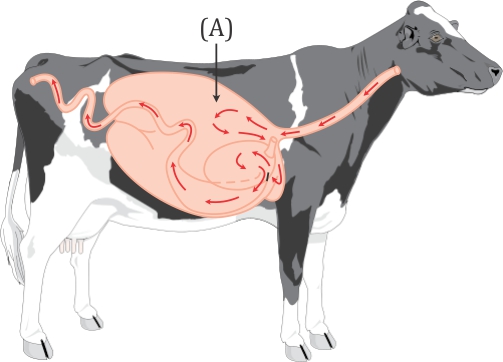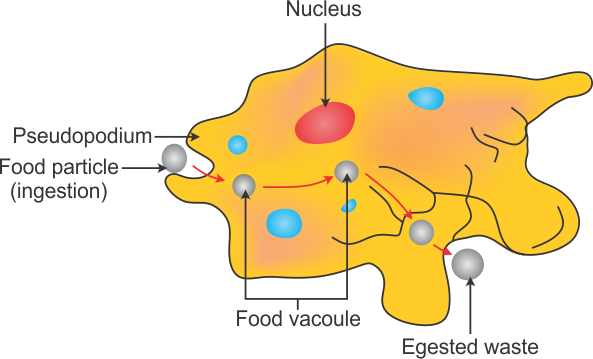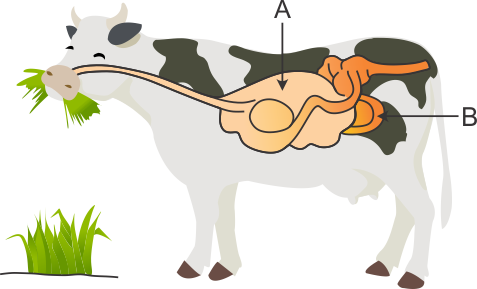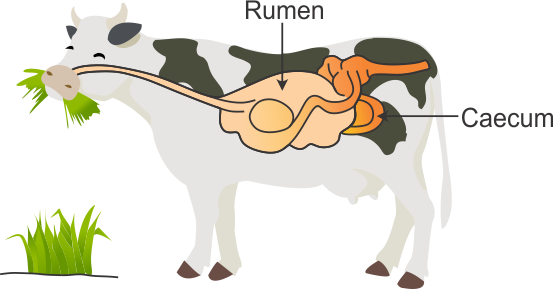Q1. Liver does not secrete any digestive juice.
Solution
False
Liver secretes a digestive juice called bile which helps in the digestion and absorption of fats.
Q2. Identify the part of the stomach denoted as 'A' in the given image.

Solution
In the given image, A denotes rumen which is a part of the digestive system in ruminants.
Q3. The process of swallowing grass and storing it in a part of the stomach is called absorption.
Solution
False
The process of swallowing grass and storing it in a part of the stomach is called rumination.
Q4. Grass eaten by the ruminants gets stored in the
Solution
Ruminants such as cow swallow the grass quickly, chew it little and then store it in the rumen which is the first compartment of their stomach.
Q5. Write the functions of hydrochloric acid secreted by the inner lining of the stomach.
Solution
Functions of hydrochloric acid: i. It kills many bacteria that enter along with the food. ii. It makes the medium in the inner stomach acidic and helping the digestive juices to act.
Q6. Swallowed food passes into the stomach through oesophagus.
Solution
True
Q7. Which gland secretes bile juice and where it gets stored? What is its function?
Solution
Liver secretes bile juice which is stored in a sac called the gall bladder. Bile juice helps in the digestion of fats.
Q8. The partly digested food completes its final digestion in the liver.
Solution
False
The partly digested food completes its final digestion in the small intestine.
Q9. Grass eaten by ruminants are stored in _____________.
Solution
Rumen
Q10. Man cannot digest cellulose.
Solution
True
Q11. The inner lining of the stomach secretes mucous, _______________and _______________.
Solution
hydrochloric acid, digestive juices
Q12. Why cellulose is digested in cow but not in human?
Solution
Cow has certain bacteria which digests cellulose but human beings do not have such bacteria or enzymes that can digest cellulose.
Q13. Describe different types of teeth and state their functions.
Solution
There are four types of teeth in human beings. They are incisors, canines, premolars and molars. (i) Incisors are the chisel shaped teeth at the front of the mouth. The incisors are for biting and cutting the food. (ii) Canines are the large, pointed teeth just behind the incisors. The canines are for piercing and tearing the food. (iii) Premolars are the large teeth just behind the canines on each side. Premolars have large, flat surfaces. The premolars are for crushing the food. (iv) Molars are very large teeth which are present just behind the premolars, towards the back of our mouth. The molars have a larger surface area than premolars. The molars help in chewing and grinding the food.
Q14. (i) Name the largest gland in human body. Where is it situated?(ii) Where are pancreas located? What are its functions?
Solution
(i) Liver is the largest gland in the human body. It is situated in the upper part of the abdomen on the right side.(ii) Pancreas are located just below the stomach. It secretes pancreatic juice which acts on carbohydrates, fats and proteins and changes them into simpler forms.
Q15. The _____________ and the associated glands constitute the digestive system.
Solution
digestive tract
Q16. Why do grass-eating animals keep chewing continuously even when they are not eating? What is this process called?
Solution
Grass-eating animals quickly swallow the grass and store it in the rumen. Here, the food gets partially digested and returns to the mouth in small lumps. So, grass eating animals keep chewing continuously even when they are not eating. This process is called rumination.
Q17. (i) Draw a neat labelled diagram of Amoeba.(ii) What is the function of pseudopodia in Amoeba?
Solution
(i) Amoeba:
 (ii) Pseudopodia in Amoeba helps in capturing of food and provides movement to it.
(ii) Pseudopodia in Amoeba helps in capturing of food and provides movement to it.
 (ii) Pseudopodia in Amoeba helps in capturing of food and provides movement to it.
(ii) Pseudopodia in Amoeba helps in capturing of food and provides movement to it.
Q18. In the given diagram, label part A and B.

Solution

Q19. What is the function of pseudopodia in Amoeba?
Solution
Finger-like projections called pseudopodia in Amoeba help to capture food and provide movement to it.
Q20. How is digested food absorbed in the small intestine?
Solution
The inner walls of the small intestine bear numerous finger-like outgrowths called villi which increase the surface area for absorption of digested food. The digested food is then transported to the different organs in the body by the blood vessels.
Comments
Post a Comment